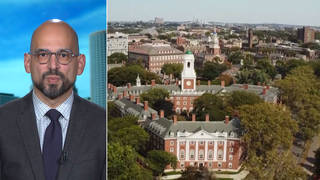
Topics
Guests
- José Luis Moríninternational human rights attorney, professor at John Jay College of Criminal Justice and chairperson of the Latin American and Latina/o Studies Department.
Last month, the Inter-American Commission on Human Rights called on Washington to pay reparations to Panama over George H.W. Bush’s illegal invasion there in 1989. We speak with international human rights attorney José Luis Morín, who has been working since 1990 to secure reparations for Panama. He is a professor at John Jay College of Criminal Justice and chairperson of the Latin American and Latina/o Studies Department.
More from this Interview
- Part 1: Greg Grandin: George H.W. Bush’s 1989 Invasion of Panama Set the Stage for U.S. Wars to Come
- Part 2: Inter-American Commission on Human Rights: U.S. Owes Reparations to Panama over Bush’s Invasion
- Part 3: How George H.W. Bush’s Pardons for Iran-Contra Conspirators Set the Stage for Trump’s Impunity
- Part 4: Ariel Dorfman: George H.W. Bush Is Alive in His Many Victims Across the Globe, Including Me
- Part 5: ”AMLO Stands Alone in the Hemisphere”: Mexico’s President Takes Office with Ambitious Leftist Agenda
Transcript
AMY GOODMAN: This is Democracy Now! I’m Amy Goodman, with Juan González.
JUAN GONZÁLEZ: As we continue to look back at the legacy of former President George H.W. Bush and the 1989 U.S. invasion of Panama, I’d like to go back to the 1992 award-winning documentary The Panama Deception. In this clip, community leader Rafael Olivardia and investigative journalist Robert Knight talk about U.S. military atrocities in Panama. We hear first from Olivardia.
RAFAEL OLIVARDIA: [translated] There were many Panamanian troops at the Balboa concentration camp. They didn’t seem to know what was going on. They were sitting on the grass with their arms and feet tied with plastic bands. I, along with many other people from El Chorrillo, witnessed their execution right in front of us. Eight of the soldiers at the entrance were executed by U.S. troops.
ROBERT KNIGHT: A Spanish news photographer, who in the early moments was able to get a picture of bodies lined up in the morgue, was subsequently shot under very strange circumstances. There was not a conflict, but, according to the reports of colleagues, an American soldier just up, took aim and shot him down.
What happened in Panama is a hidden horror. Many of the bodies were bulldozed into piles and immolated in the slums where they were collected. Other bodies were left in the garbage chutes in poor projects in which they died from the shooting, from the artillery, from the machine guns, from the airborne attacks. Others were said to have been pushed into the ocean.
AMY GOODMAN: That was Robert Knight, the late reporter for WBAI, in the documentary, the Oscar-winning documentary, Panama Deception. Last month, the Inter-American Commission on Human Rights called on Washington to pay reparations to Panama over what was widely seen as an illegal invasion.
We’re joined now by international human rights attorney José Luis Morín, who has been working since 1990 to secure reparations for Panama. He’s now a professor at John Jay College of Criminal Justice and chairperson of the Latin American and the [Latina/o] Studies Department at John Jay. As well as Greg Grandin joining us from New York University.
José Luis Morín, you get a job at the Center for Constitutional Rights in 1990. Your first day on the job, you’re on a flight to Panama?
JOSÉ LUIS MORÍN: My first day on the job was to get on a plane to be part of a delegation to investigate the reports of civilian victims of the U.S. invasion. And this was a delegation of the National Lawyers Guild. I was there as part of—as an attorney for the Center for Constitutional Rights. And among the persons that joined us was attorney Gilma Camargo, who has continued to be the attorney for the victims, after I left the Center for Constitutional Rights.
JUAN GONZÁLEZ: It’s taken almost 30 years for a judgment on what happened in Panama to come out from an international body? Can you talk about that, why it took so long to be able to get this?
JOSÉ LUIS MORÍN: Well, when you’re going against the most powerful country in the world, there’s going to be pushback. And clearly, the United States, at every stage of this case, attempted to claim that the Inter-American Commission didn’t have the competency, that we had not exhausted all remedies, as required under international law and the procedures of the commission. And so, at every stage, the United States was—and it continues to deny its responsibility.
AMY GOODMAN: Talk about the community, the neighborhood, that was hit the hardest. We’re talking a bomb every few minutes, massive bombing of Chorrillo.
JOSÉ LUIS MORÍN: So, El Chorrillo is a poor neighborhood located in Panama City. And it is also the site of the Comandancia, the headquarters of the military. What the United States claimed is that it was doing a surgical strike, but it became very obvious that a whole neighborhood was put up in flames and was being destroyed in the invasion. And that meant that civilians were being targeted indiscriminately. And that’s what’s important about the commission’s findings, is that they did find civilians having been targeted indiscriminately and that the United States was not taking the precautions necessary. It was acting in a very reckless and arbitrary way in how it was trying to meet its military objectives. And under international law, that’s prohibited.
JUAN GONZÁLEZ: And Panama also became the place where the United States tested some of its newest weaponry. Wasn’t the B-1—the stealth bomber was first used in combat—
JOSÉ LUIS MORÍN: That’s correct.
JUAN GONZÁLEZ: —in Panama, as well?
JOSÉ LUIS MORÍN: That’s correct. And so, that also struck fear in the population, because there was all this unusual weaponry that was being used. It was also the first time that the Humvee was being used, as well, which replace the military jeep. There was all sorts of ways in which the population was being intimidated as part of this process. And because so many of these neighborhoods were the poorest, were the places where, you know, black and brown Panamanians live, they could be ignored, and they could be marginalized.
AMY GOODMAN: Let’s go back to the Oscar-winning documentary The Panama Deception.
NARRATOR: The Pentagon used Panama as a testing ground for newly developed high-tech weapons, such as the stealth fighter, the Apache attack helicopter and laser-guided missiles. There are also reports, that can’t be explained, indicating the use of experimental and unknown weaponry.
CECILIO SIMON: [translated] We have testimony about combatants who died literally melted with their guns as a result of a laser. We know of automobiles that were cut in half by these lasers, of atrocities committed by weapons that fire poison darts which produce massive bleeding.
AMY GOODMAN: That clip from The Panama Deception ends with University of Panama professor Cecilio Simon. José Luis Morín, tell us who José Isabel Salas Galindo is, the named person in the suit.
JOSÉ LUIS MORÍN: So, Salas is the lead petitioner in this case. We had a total of 272 cases that were filed with the commission. His case was quite compelling, because not only did he suffer injuries, but his wife, Dionisia, who was at home at the time, in a building that’s known as a 15-story building, was struck with artillery fire. She was in the kitchen at the time. Her body was destroyed—I mean literally destroyed—in that attack, while she was at home, and in ways that were just indescribable. People described that they had—because her remains were scattered in the kitchen, had to be shoveled into a body bag. The other family members, also in that attack, also suffered injuries, and they’re part of the case.












Media Options